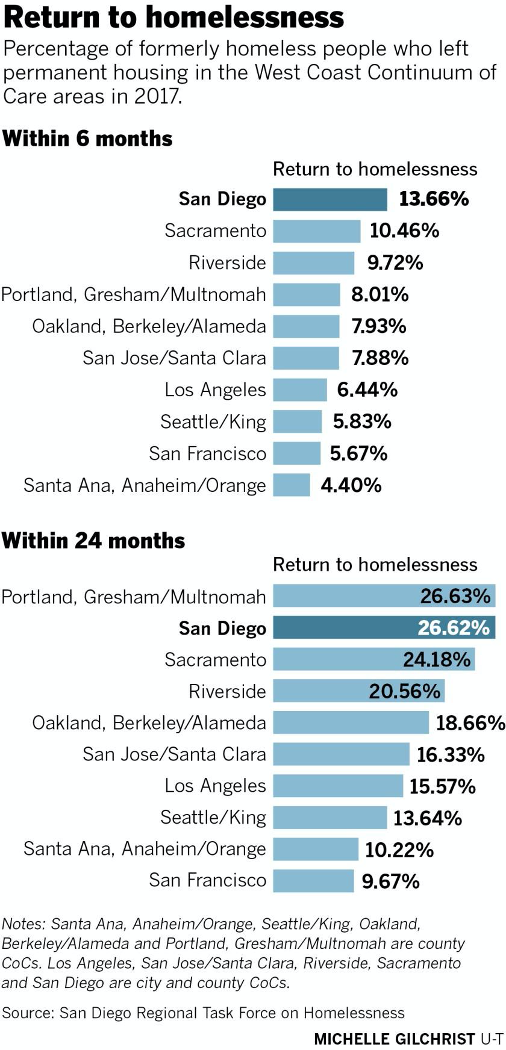Published on
On Fixing San Diego’s Homelessness Epidemic: Expanding Fast and Free Training

The Problem
A recent report published by the Department of Housing and Urban Development found that the County of San Diego has the fourth-highest homeless population in the country—an epidemic prompting elected officials, nonprofit executives, and industry leaders to take big yet costly steps to control the growing public crisis.[1]
To address the epidemic, the San Diego Regional Task Force on the Homeless (RTFH)–a group of government and nonprofit stakeholders committed to preventing and alleviating homelessness in San Diego—was formed.
RTFH conducts a yearly point-in-time count of the county’s homeless including unsheltered (those living on the streets, in automobiles, abandoned buildings) and sheltered (those living in private or public temporary housing). The January 2018 count concluded that:
- San Diego’s homeless population is the fourth largest in the country.
- There are 8,102 homeless persons in San Diego county.
- 10% of the total homeless population are veterans.
- 36% of the total homeless population reported having a physical disability.
- 12% of the total homeless population are youth under the age of 24.
- 78% of the total homeless population reported becoming homeless in San Diego.
Although these statistics are alarming, they reflect only a snapshot of the problem on a specific day of the year. In actuality, the homeless issue is much larger, and it is widely agreed that there are significantly more homeless people residing in San Diego County than the point-in-time count reveals.[2]
In early 2020, RTFH counted 7,619 homeless people residing in San Diego County. Nearly 1,800 volunteers including 500 county employees took part in the counting event, which found a 6% reduction in the homeless population from the 2019 numbers. Although the count suggests a small decline in the number of people living on the streets, the epidemic persists. Further, the demographics of those impacted by homelessness remained constant.[3]
The Response
In addition to assessing the scope of San Diego’s homelessness epidemic, RTFH has facilitated the expansion of academic research on housing insecurity and supported the diversification of supports and resources to serve homeless people in our community. In one of the boldest moves by communities in the state grappling with this epidemic, the City of San Diego constructed massive taxpayer-funded tents, trailers and other facilities to house San Diegans who were living on the streets and in their vehicles.
In October 2019, Mayor Kevin Faulconer, who has worked thoughtfully to end the epidemic, wrote: “Two years ago . . . the City of San Diego identified locations, constructed, and then opened three massive new structures, which increased our shelter capacity by nearly 700 beds for men, women, and children. The program has helped hundreds of people go on to find housing,” as he built a case for funding the additional tents.[4]
In some respects, the tents have been successful in moving homeless people off the streets because a few thousand people have benefited from the safety and shelter that the tents provide. However, the homelessness epidemic cannot be fixed by focusing solely on housing.
Let me be clear: there is a huge debate over the value and mission of the tent structures. Some critics argue that this funding should be used to build permanent housing instead. I appreciate the arguments both parties assert. But I want to challenge conventional wisdom about how to best help people overcome housing security challenges.
Many homeless advocates, whom I respect and admire, argue that society can solve homelessness by simply building more housing. Rapid Re-Housing is a relatively recent innovation in social policy. It’s an intervention designed to help those who are homeless. As described by the National Alliance to End Homelessness, Rapid Re-Housing is a subset of the Housing First approach to end homelessness. However, placing a homeless person in permanent housing does not ensure that they have the capacity to become self-sufficient.
In November 2019, the San Diego Union Tribune reported noteworthy statistics regarding the number of local residents who return to the streets after overcoming homelessness. They return to the streets within six months at a greater rate than in other West Coast cities, and almost 80% of them became homeless while living locally.
In November 2019, the San Diego Union Tribune reported noteworthy statistics regarding the number of local residents who return to the streets after overcoming homelessness. They return to the streets within six months at a greater rate than in other West Coast cities, and almost 80% of them became homeless while living locally.

The Solution
After the immediate needs of adults in transition from homelessness to permanent housing are met (e.g., housing, mental and physical health, substance abuse, childcare, transportation, etc.), deliberate efforts must be taken to incentivize their participation in intensive, short-term free adult noncredit career education certificate programs—particularly now that the COVID-19 pandemic has devastated the American economy and job market.
Joblessness remains pervasive throughout California and the United States, even as states continue to reopen. Many San Diego residents who were employed in early 2020 are now experiencing housing insecurity. Most of these displaced workers already possess a strong work ethic. They do not want to rely on government assistance. Even as employers begin to rehire furloughed workers, the unemployment rate remains higher than any point in modern history.
The shutdown caused by the pandemic initially was predicted to last several weeks, but elected officials and healthcare leaders continue to express uncertainty about the pathway forward. As the shutdown continues to be extended, our community’s most vulnerable residents have been forced to shoulder the brunt of the burden. Further, many industries are not sure if, or when, normal operations will return.
Now, more than ever, we need to focus on relevant, free, and fast job training for adults experiencing homeless. San Diego Continuing Education (SDCE), the San Diego Community College District’s continuing education division, provides over 75 tuition-free career education pathways for any adult (18+) resident of California. These programs (e.g. coding, cybersecurity, welding, plumbing, culinary arts, and automotive) are designed to quickly move lower-skilled workers into meaningful careers that pay them livable wages.
Three years ago, SDCE started a partnership with the San Diego Rescue Mission (SDRM) to provide vocational educational services to homeless adults enrolled in SDRM’s long-term rehabilitative facility. The Rescue Mission provides housing, substance abuse treatment, mental and physical health services, childcare, transportation, food, clothing, and other critical basic needs to their residents. I applaud the holistic approach to client services that they have embraced.
In spring of 2018, twelve Rescue Mission clients enrolled at SDCE in a new pilot program called “Rising to Success Pathways” (R2SP), which works to break down barriers to student success by providing inclusive learning environments supported through increased access to and enrollment in SDCE’s free career training programs and targeted student support programs.
Program participants receive intensive case management, inclusive counseling, financial supports for incidentals (e.g., bus passes, meal vouchers, laptops, textbooks, etc.), paid experiential learning opportunities (internships in their respective career paths), and guaranteed admission into the San Diego Promise, which offers two years of free community college plus $1,000 stipends for textbooks and other costs to students who want to continue their studies in pursuit of a credit degree or certificate.
The first R2SP cohort thrived with eleven of the twelve students completing certificate programs and transitioning to employment. Last year, SDCE enrolled 628 in R2SP. It is unfortunate that current funding caps the number of formerly homeless students we can serve because SDCE’s model is working.
While I applaud the efforts of local community leaders to combat the homelessness epidemic through rapid rehousing efforts, we must all question what happens to these individuals and their families after we place them in housing. Housing alone cannot address the epidemic. Free adult noncredit education through R2SP provides a proven model to facilitate the rapid reintegration of our community’s most disadvantaged residents back into society.
When COVID-19 forced SDCE to stop offering in-person instruction, the SDCE Foundation raised funding to purchase laptop computers and wifi devices to ensure that our most marginalized students could continue their education.
Over the past three months, SDCE distributed over 1,150 laptops, thanks in part to the generosity of the San Diego Foundation, the Lucky Duck Foundation, and the United Way of San Diego County. Despite these efforts, the technological divide persists, so we need additional support from our community.
Further, this model does not exist in other large metropolitan regions facing similar challenges with limited low-income housing. No other city in California provides the breadth of free noncredit career training opportunities that the San Diego Community College District does.
This month, SDCE launched the Interactive Competency-Based Online Microcredentialing (ICOM) Academy—California’s first fully accredited, fully online adult noncredit career training institute. Anyone who resides in the state of California can choose between 16 distance education job training certificates for free.
References
[1] O’Reilly, Andrew. “San Diego spending millions to build elaborate tent facility for homeless.” Fox News Channel. June 24, 2019 https://www.foxnews.com/politics/san-diego-spending-millions-to-build-elaborate-tent-facility-for-homeless
[2] The Lucky Duck Foundation. https://www.luckyduckfoundation.org/homeless-epidemic/
[3] City News Service. “San Diego’s Pre-Pandemic Homeless Numbers Decreased from Last Year: Report. April 28, 2020. “NBC San Diego 7. April 28, 2020.
[4] Faulconer, Kevin.” How San Diego Cleaned Up Its Act—And Got Real On Homelessness.” Hoover Institution. October 30, 2019.



